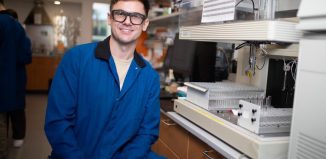BNL’s Ben Babst studies plant growth and metabolism
Engineering hardier plants could feed a growing population or provide biofuel
The sports adage, “it’s not the size of the athlete in the fight, but the size of the fight in the athlete,” might apply to Ben Babst’s research.
Instead of studying athletes, the Brookhaven National Laboratory researcher is looking at something that fights numerous unseen battles — plants.
A postdoctoral fellow at BNL since 2010, Babst uses positron emission topography scans to track how labeled elements move and change as they go through plants. This is the same technology doctors use to test for breast or lung cancer.
Babst is examining corn, sorghum, grasses and some of their relatives to understand how they grow and respond to their environment. He is also looking at what makes some grow bigger than others, while others tolerate drought or low-soil nutrients.
“We need to understand the underlying mechanism for fast growth, for stress tolerance, for pest resistance,” he offered. “We are not only measuring how big they are or how they look, but what they are doing inside. [We are looking at] what is happening with their metabolism and with signaling.”
The benefits of understanding plant growth apply to the conversion of plants to biofuels and the expansion of previously unused or undeveloped land for agriculture. Down the road, this could enhance our ability to generate plants to feed the increasing global population and to provide alternative, sustainable energy.
“One of our major goals is to come up with new strategies to find or engineer plants that can grow vigorously on lands not useful for food production,” he explained. “Another goal is to find new strategies to develop plants that have a biochemical composition favorable for conversion to fuel, for example high sugar or starch content.”
The challenge is to combine all the desirable traits into one crop.
Through agriculture, farmers have gone through a selection process that might not benefit the plants, or us, in the long run.
By watering, fertilizing and using pesticides to get rid of insects, bacteria and fungi, we have produced plants with an unintentional loss of hardiness. By cultivating plants under these conditions, we may have diminished the resistance plants might have to some of these challenges.
Babst and his colleagues are studying plant hormones, called phytohormones, to see how they protect plants. The plant hormones might tell a tree in a drought to close the pores on its leaves to prevent water loss.
“A recent new direction for the group is that we’re using carbon 11 [a radioactive carbon that’s easy to see with the advanced technology] to label specific phytohormones and biomolecules,” he explained. “We are looking to see how the phytohormones are made and if, under different treatments, they are made at different rates.”
He is also looking at movement of the phytohormones because the rate of that movement might determine their effect.
Babst started working with PET when he did his Ph.D. research at Tufts University. While he was there, he simulated an insect infestation with plants to determine their reaction. To his surprise, the plants in his experiment hid some of their precious resources in their roots, farther away from what they perceived as a threat from insects that might steal their sugars.
“I had a different project goal in mind,” he recalled. “When I saw that plants were bunkering their resources down in the roots after a herbivore attack, I was pretty excited. It changed the course of my research.”
In addition to seeking basic information about plant growth and metabolism, Babst also hopes to contribute to an understanding of how to harness plants for biofuel and how to help find plants that might grow in areas of the world people had once thought couldn’t sustain plant growth.
“Energy is central to our economy and has an impact on everybody’s everyday life,” he said. “I’ve noticed [in recent years ] that every time the economy seems to get moving, gas prices and energy prices go up and that muzzles economic progress.”
A married father, Babst lives in Manorville with his wife Clare Norcio, an adjunct professor of history, and two primary-school children.
He recently took his children to the pumpkin festival at Suffolk County Farm. He enjoys hiking along some of the trails on Long Island.
“When I see plants, I see one that looks stressed, or one that has caterpillars that have mauled it. Sometimes, I see it for its beauty. I’ll see an understory plant that looks so tiny but is probably decades old.”






